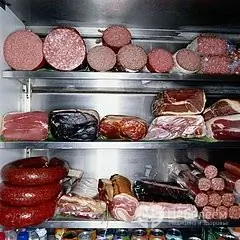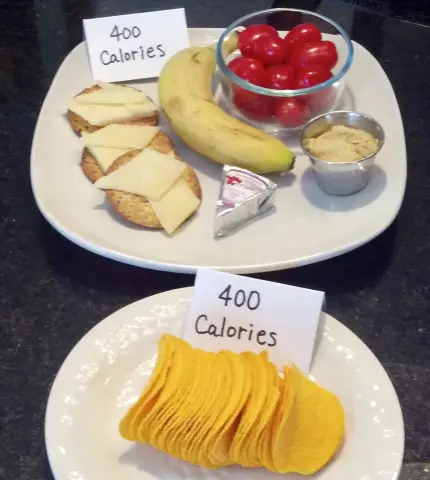- Author Rachel Wainwright [email protected].
- Public 2023-12-15 07:39.
- Last modified 2025-11-02 20:14.
What are a lot of calories?
What are calories? What are a lot of calories? Anyone who wants to eat right has to answer these questions for themselves. Calories in food are a measure of how much energy we get from food. Cells need energy to do their job. If a person has a normal weight, then it is desirable for him to receive with food and spend on loads the same number of calories every day. However, people who dream of losing weight are often interested in the question of what are the many calories. In fact, all weight loss diets and nutritional systems are built around substantial restriction of high-calorie foods.

How are food calories counted?
Special tables are used to calculate calories. They can be easily found in specialized literature or on the Internet. These tables list foods and give their energy value per 100 grams. What are a lot of calories? In those foods that contain more than 400 calories per 100 grams.
Different people should consume different amounts of calories in just one day. On average, the diet should contain 1200-2500 kilocalories per day. In order to know exactly how many calories you are consuming, you need to use a kitchen scale and keep a food diary. Such records will help you count food calories constantly and adjust the menu. To calculate the calories in food per day, you need to record all the foods you ate and the weight of the serving in grams. Further, the calorie content of each dish is calculated separately, and all the results are summed up.
Example of counting calories in food
For example, let's calculate the calorie content of one meal. So, a person ate an egg for breakfast, two milk sausages (100 grams), Ukrainian bread (25 grams), a glass of milk 3.2% fat (250 grams).
We find each product according to the calorie tables. Eggs contain on average about 70 calories per egg. Dairy sausages contain 260 calories per 100 grams. Milk of this fat content has 58 kilocalories per 100 grams. In our example, we have 250 grams of the product, which means that we need to multiply 58 by 2.5. We get 145 calories in a serving of milk. This type of bread contains 213 calories per 100 grams. In 25 grams, there will be, respectively, (213 × 0.25) = 53.2 kilocalories. Now we need to summarize the calorie content of all dishes. It turns out 70 (egg) + 260 (sausages) + 145 (milk) + 53.2 (bread). Only 528.2 kilocalories for this meal.
What are many calories in our diet?
Many people find it rather tedious to constantly count the calories in food. This requires not only self-discipline, but also time, as well as accurate knowledge of the mass of each serving. Sometimes it is enough to simply take into account the approximate energy value of food. Such a system is especially suitable for those who do not seek to lose many kilograms, but simply try to adhere to proper nutrition in order to maintain their figure. According to this method, foods with high calorie content should be almost completely excluded from the menu. Medium calorie foods may be present in the diet, but only in small quantities. But low-calorie foods can be consumed in almost any quantity. Then the question arises before us, what are the many calories? What products will you have to refuse?
High-calorie foods are primarily fat-rich foods. The calorie content of carbohydrates and proteins is much lower. Vegetable oil has the highest calorie content of all food products. It contains about 900 kilocalories per 100 grams, which significantly exceeds the energy value of bread, sugar, and even lard. Butter is also very high in calories (700 kilocalories per 100 grams).
Mayonnaise is one of the figure's worst enemies. 100 grams of this sauce (and this is just a few tablespoons) contains up to 630 kilocalories. Chocolate, even bitter chocolate, also contains a lot of fat, and therefore calories. There are more than 500 calories in 100 grams of chocolate. Nuts and seeds are also rich in fats. In 100 grams of different varieties, there are more than 500 calories.
Smoked meat products, lard, fatty pork, lamb are high in calories. They rarely contain less than 450-550 kilocalories per 100 grams.
Medium calorie foods
These products include bread, potatoes (except fried ones), cereals, rice, pasta, boiled sausage, sausages, dairy products with medium fat content, fruits. The energy value of these products is mainly formed due to the caloric content of carbohydrates in their composition.
Such food can and should be included in your diet. To lose weight, cut your regular portion of bread and side dishes in half. Almost every person needs 50 grams of bread per day. As for potatoes, rice, porridge, pasta, their volume should not exceed a third of the volume of each meal. So, one third is a protein product (meat, fish, chicken). Another third is vegetables (except potatoes). And the rest is any side dish.
Low calorie foods
It is with these products that you need to quench your appetite in the evening. Those who are on a diet should eat them more. Fiber, water, trace elements and vitamins form the basis of these types of food. Low-calorie foods include vegetables, except for potatoes, mushrooms, low-fat dairy products.
Water, tea and coffee without sugar, herbal infusions do not contain calories. They can be drunk in large quantities to "cheat" the appetite.

Caloric content of carbohydrates, fats, proteins
We looked at food groups depending on their calorie content. If we talk about the composition of food, then the most high-calorie components are fats. One gram of fat contains 9 kilocalories. The benefit of fat is that the body absorbs many vitamins with it. Therefore, it is impossible to completely abandon fats. Moreover, it would be rather difficult to do this. In many foods, fat is hidden.
Protein contains 4 kilocalories per gram. This is relatively small. In addition, energy from proteins is absorbed slowly. It takes the body several hours to digest protein foods
How many calories are in carbs? The same as in proteins: 4 kilocalories in 1 gram. But carbohydrates are digested much faster. Some of them (glucose, fructose, sucrose) do not require digestion at all. As soon as such carbohydrates enter the stomach, their absorption into the blood begins. Calories in other carbohydrates ("slow" ones) are absorbed within 1-3 hours. The calorie content of carbohydrates is not too high, but we traditionally consume foods containing them in large quantities. Flour, potatoes, pasta, bread can cause obesity.
Separately, it should be said about the calorie content of alcohol. Each gram of pure alcohol contains 7 kilocalories. In addition, alcohol is absorbed extremely quickly. Of course, alcohol should be limited to those on a diet. Its disadvantages include the ability to remove all kinds of psychological prohibitions, including deliberate restriction of food. Having drunk at the festive table, we run the risk of severely disrupting the diet. At this point, few people will care how many calories are in carbohydrates or what are many calories.
Found a mistake in the text? Select it and press Ctrl + Enter.






